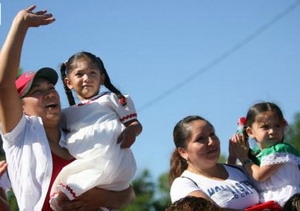
One of the most significant demographic trends of the past 20 years is the explosive growth of Hispanics. Now at 50 million, almost one in six Americans, Hispanics have more than doubled their numbers in 1990.
The Hispanic boom has spread far beyond traditional immigrant gateways such as California and Florida, altering the American landscape in states such as Kansas and North Carolina.
Just more than 1% of North Carolina 6.6 million residents were Hispanic in 1990. In 2010: Almost 7% of 9.5 million people were.
Asians grew at a similarly rapid rate but they still account for a small share of the population (4.7%). Since 2000, more Asians were added (4.3 million) to the population than blacks (3.7 million).
Hispanics surpassed blacks in 2003. African Americans' presence in some traditional strongholds is shrinking. They are leaving cities and heading for the suburbs or returning to the South.
The end of the first decade of the 21st century marks a turning point in the nation's social, cultural, geographic, racial and ethnic fabric. It's a shift so profound that it reveals an America that seemed unlikely a mere 20 years ago, one that will influence the nation for years to come in everything from who is elected to run the country, states and cities to what type of houses will be built and where.
The metamorphosis over just two decades stuns even demographers and social observers.
"An entire Venezuela's worth of Hispanics was added in just those two decades," says Robert Lang, an urban sociologist at the University of Nevada-Las Vegas. That's about 30 million, or half of the nation's growth since 1990.
"By 2050, Americans will look back at the controversies around immigration, controversies about diversity and wonder what the big deal was," Lang says.
The traditional nuclear family, one or two adults and their young children, continues to ebb. In its place, a grab bag of alternatives has appeared or begun growing after decades of decline.
Among families, various forms of three generations under one roof; adult children returning to their parents' home, sometimes with a spouse and their own children or both; blended families that include stepparents or stepchildren; and extended families that include a parent, a child, cousins and others, related or not.
A growing share of homes includes more than one generation of a family. The average household size has stopped shrinking and begun to grow for the first time in a half-century, partly buoyed by the influx of immigrant families.
Immigrants are more likely to have young children and live with siblings, parents or other relatives. By one broad definition, 16% of U.S. households are multigenerational (two or more), up from 14% in 1990, according to the Pew Research Center. The Census defines multigenerational as three or more generations of the same family. In 2010, they made up 4% of households.
Only one-third of households now have children, and the share of households that have kids under age 18 dropped in 95% of counties, changing the flavor of neighborhoods in cities and suburbs.
One of the biggest changes is the delay and eclipse of marriage. Half of women who marry wait until 26 to do so, up from 24 in 1990. For men, half don't marry until they are older than 28, up from 26.
Part of the delay may stem from higher education levels. Women have made such giant leaps that they now dominate men at every level of higher education in earning degrees. The most recent Department of Education statistics show that 51% of doctoral degrees went to women in 2007-08, up from 42% in just 10 years.
The educational gender gap is widening, but men's life expectancy, still lagging women's, is rising at a faster rate.
Source: USA Today, Census tracks 20 years of sweeping change, August 10, 2011.
Oct 10, 2011
Topics: